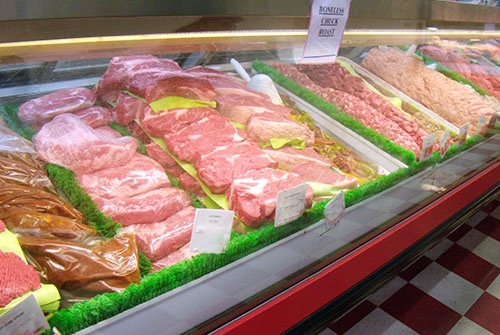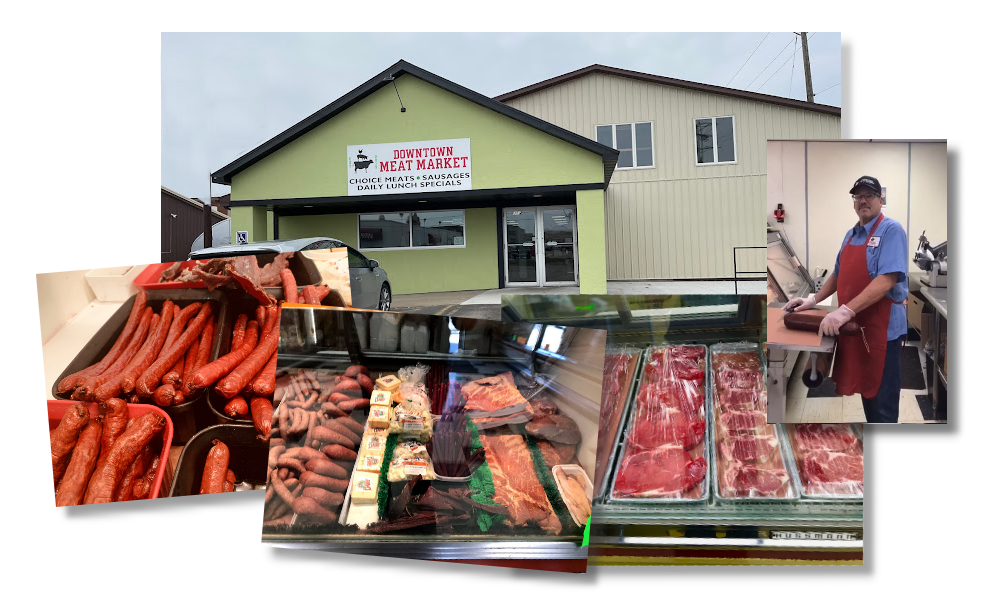Get the Best Deals on Fresh Meat at Bagley Farms Meat Market Edwardsville IL
Get the Best Deals on Fresh Meat at Bagley Farms Meat Market Edwardsville IL
Blog Article
Reveal the Art of the Butcher's Cut in a Modern Meat Market
In the ever-evolving landscape of modern-day meat markets, the butcher's cut has transcended its conventional origins, combining age-old workmanship with modern methods. bagley farms meat market edwardsville il. Today's butchers are not simply cpus of meat; they are experienced craftsmens that stress sustainability and honest sourcing. Their competence in picking and preparing cuts customized to details culinary needs uses an exceptional dining experience. Yet, what truly sets the modern butcher apart is their capability to forge a deeper connection in between customers and the origins of their meat. Exactly how do these masters equilibrium custom with development, and what implications does this have for the future of meat consumption?
Evolution of Butchery Techniques

The mid-20th century saw butchery strategies even more improved by clinical understandings into muscle mass biology and meat aging, boosting both tenderness and preference. Technologies like vacuum packaging and refrigeration extended product shelf-life, allowing butchers to expand offerings and boost quality assurance. This period likewise marked the increase of specific tools, such as band saws and meat slicers, which enhanced accuracy and effectiveness in meat handling.
The 21st century has presented digital modern technology right into the butchery realm. Computerized systems now help in tracking animal provenance and maximizing cuts to meet particular customer choices. Furthermore, a renewal in artisanal butchery has emerged, mixing conventional abilities with modern-day understanding to cater to consumers looking for honest and sustainable meat choices. This development underscores a vibrant interaction between tradition and technology, conference contemporary needs while preserving the craft's heritage.

Comprehending Meat Cuts

Recognizing the ins and outs of meat cuts is important for both butchers and customers seeking quality and value. For butchers, specific cuts mirror ability and regard for the craft, making certain minimal waste and ideal yield.
The primary categories of meat cuts consist of primal, sub-primal, and retail cuts. Butchers then break these down better right into sub-primal cuts, prior to lastly producing retail cuts readily available to customers, like ribeye or tenderloin.
Understanding muscle make-up is crucial; muscles used much more regularly by the animal often tend to be tougher and are best fit for slow-moving cooking techniques, while less-used muscle mass, like those found in the loin, are a lot more tender and ideal for cooking or roasting. Knowledge with these pop over to this web-site differences equips consumers to make educated options, boosting their culinary endeavors.
Picking Top Quality Meat
Selecting the appropriate meat entails more than simply picking a visually attractive item from the display screen. The art of picking high quality meat calls for a critical eye and knowledge of specific characteristics that represent quality and quality. Pay focus to the color; beef should have a bright, cherry-red hue, while lamb should show a soft pink tone, and pork a light pink. This suggests the meat is fresh and hasn't been exposed to oxygen for too lengthy.
Second of all, consider the marbling, which describes the white flecks of fat within the muscular tissue. Appropriate marbling is a key indication of inflammation and flavor, as it melts throughout cooking, improving the meat's juiciness. Remember, greater marbling commonly correlates with superior high quality cuts, such review as USDA Prime.
Texture is an additional vital factor; meat must feel solid to the touch, not slimed or excessively soft. In addition, bear in mind the fragrance. Fresh meat ought to have a tidy, neutral scent, without any kind of sour or off-putting smells.
Matching Cuts With Food Preparation Techniques
Successfully matching cuts of meat with the proper food preparation approaches is necessary for achieving optimum taste and appearance. These techniques boost the meat's natural flavors and make sure a juicy finish.
On the other hand, harder cuts like brisket and chuck roast are abundant in collagen, which breaks down into gelatin when cooked slowly. These cuts are perfect for braising or sluggish roasting, enabling the meat to soften gradually and develop deep, complex flavors. Cuts such as brief ribs and pork shoulder get on well with slow-cooking techniques, where extended cooking times transform their durable appearances right into succulent dishes.
Lamb shanks and oxtail, which call for long term food preparation to tenderize, are perfect prospects for cooking or sluggish simmering. These methods coax out rich, passionate flavors while maintaining dampness. By recognizing the special qualities of each cut, chefs and home chefs alike can elevate their culinary creations, ensuring each recipe is both satisfying and memorable.
The Butcher's Duty Today
Navigating the evolving landscape of the modern-day meat market, the butcher's role today expands beyond mere prep work of cuts. Contemporary butchers are culinary craftsmens, educators, and supporters for sustainable techniques. have a peek at this site They connect the gap in between the farm and the fork by making certain honest sourcing, recognizing animal husbandry, and focusing on transparency in the supply chain. This shift shows the expanding consumer demand for high quality over quantity, where provenance and pet welfare are extremely important.
In addition to crafting specific cuts, butchers now engage straight with customers, using cooking advice and tailoring choices to fit specific needs and choices. Their competence in meat aging, marbling, and taste profiles equips customers to make enlightened decisions, improving their cooking experiences. This customized solution exhibits the butcher's evolving role as a trusted consultant in the cooking area.
Moreover, butchers are critical in lessening waste, making use of whole animals to create diverse products such as sausages and supplies - bagley farms meat market edwardsville il. This thorough strategy not only respects the animal but likewise lines up with modern sustainability objectives. This way, the modern-day butcher embodies both tradition and innovation, adapting to an ever-changing market while maintaining the virtuosity and integrity of their craft

Conclusion
Mastery in comprehending varied meat cuts and quality signs encourages butchers to offer enlightened recommendations, lining up details cuts with optimal food preparation approaches. By honoring historical techniques while welcoming contemporary demands, the butcher's duty continues to be crucial in today's innovative meat market.
Report this page